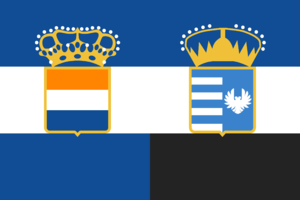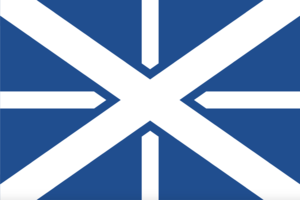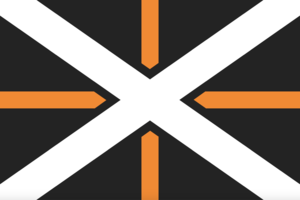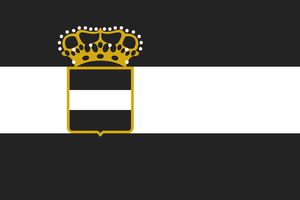Laveska
|
Laveskan Electorate
Лавесканский Электорат
(Laveskanskiy Elektorat)
|
|||||
|---|---|---|---|---|---|
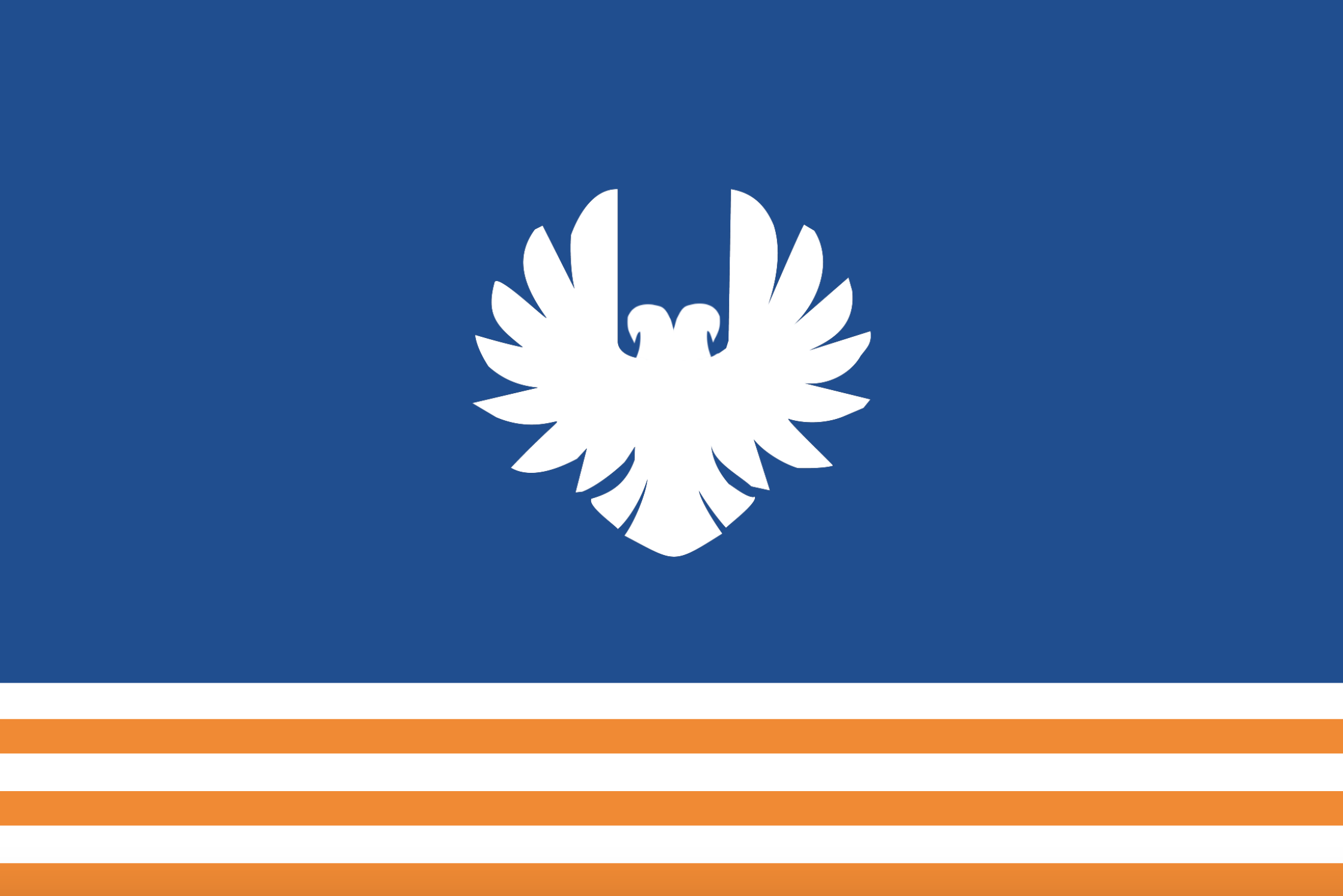 |
|||||
| Sigil of the Asimovtsy (a two-headed phoenix) over a blue field above the orange-white ribbon of the medal "For six decades' service in the Civil War" | |||||
| Common Name | Laveska | ||||
| Anthem | Дороги (Roads) | ||||
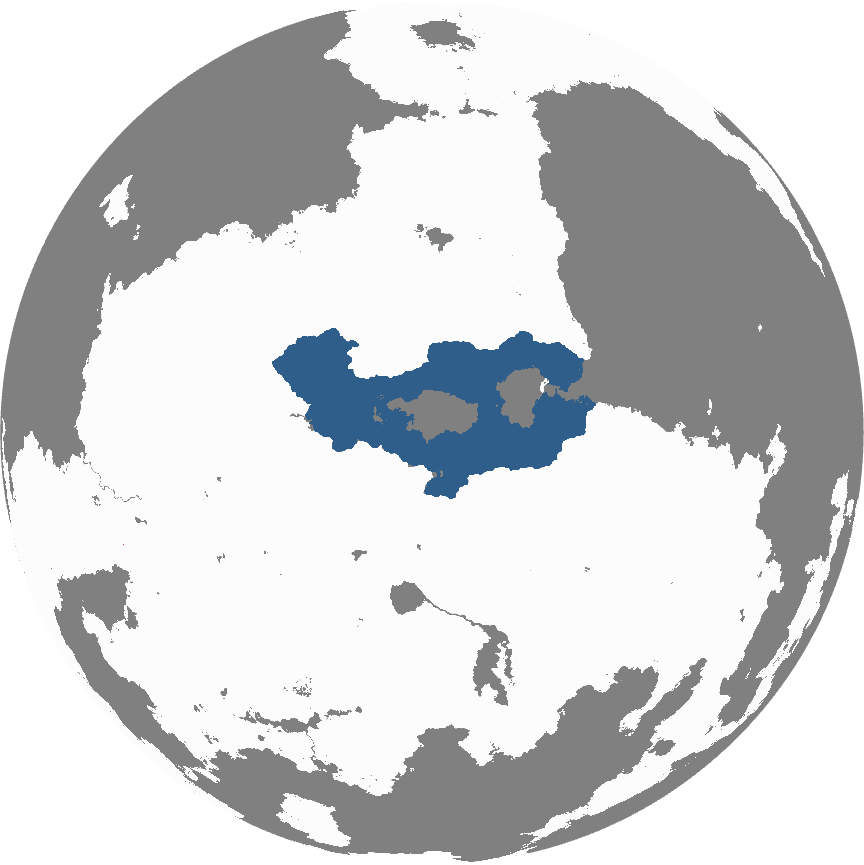 |
|||||
| Demonym | Laveskan | ||||
| Official languages | Aesori, Zeroan, Zokesian, Strelkan | ||||
| Currency | Imperial nenarius | ||||
| Politics | |||||
| Capital | Lavesk | ||||
| Government | Federal presidential constitutional republic | ||||
| Foundation | 2157 | ||||
| Elector | Isabella Vikus-Ward | ||||
| Preceded by | State Union of Laveska, Zeroa, Nautilus, and Fortmil | ||||
| Demography | |||||
| Ethnicities | Laveskan, Strelkan, Zokesian | ||||
| Population | 5,253,774 | ||||
| Area | 61,215 km² | ||||
Laveska, officially the Laveskan Electorate, is a federal subject of United Imperial Federation. It lies on the Wakirian coast and is the easternmost continental Imperial territory. It borders Zeroa to the west, an international border with Belaeseria to the north, and international borders with the Combined Provinces of Doren as well as the Republic of Taiala to the south. As a national subject of the Imperial Federation, the head of state of Laveska is also an Imperial elector in addition to domestic duties.
Prior to Aeserian colonization, the area of Laveska was the central point of a historical region known today as the Reciprocity, a culturally and linguistically diverse area plagued with conflict. The arrival of Aeserian mercenaries at the end of the first millennium led to the collapse of the old order and the region's reconstitution as a unified polity called the Freehold of the Eastern Laveskan Host, before being formally annexed into the Arcadian Tsardom as a governorate and later reconstituted into a Socialist Republic under the UASR.
Just prior to the collapse of the UASR in 1984, a progressive cultural revival known as the Reciprocian Awakening swept the Laveskan SSR and ensured its reconstitution post-collapse into the Lake Periphery States of the Spice Reciprocity. The new government sought to tear down vestiges of its Ravnine past, elevating Reciprocian cultures and delineating interstate borders along ancient ethnic lines. The Reciprocity reformed the internal troops units they inherited into a new military-civil organization devoted to the furtherance of the cultural revolution: the Blue Coats.
The Blue Coats governed the Spice Reciprocity as a confederation of the reconstituted ethnostates, limiting federal power and ensuring state primacy throughout their rule. Rife with corruption, the Coatists frequently ran afoul of scandal and was wholly unprepared for war when the Red Horde appeared on the Reciprocity's southern border. The ensuing conflict ended in victory for the Reciprocian side, but the destruction caused by the conflict combined with preexisting corruption led to the collapse of the government and the First Reciprocian Civil War. between loyalists and Dust Harvest, a rebel faction.
Dust Harvest prevailed in the conflict and reformed the country into the Dust Harvest States Upon the Lake’s Periphery. Almost immediately following the cessation of hostilities, the leader of the Northern Mercantile Collective, an omnicidal artificial intelligence called the Overlord, began covertly assassinating Dust Harvest's leadership and replacing them with robot impostors subordinate to it. The NMC also similarly compromised the leadership of the legitimist organization "Underground Reciprocity Liberation Organization." The discovery of the Overlord's subterfuge set off a chain of events that culminated in the Second Reciprocian Civil War.
The compromised leadership of the Underground Reciprocity Liberation Organization gained control of the States' ballistic missile systems and turned them on Dust Harvest-controlled cities, causing widespread destruction. A prominent member of Dust Harvest's leadership, Housen, saw the writing on the wall and broke off from Dust Harvest to form his own organization, the Reciprocian Reclamation Army, which through popular support and Zokesian arms supply prevailed over DH and URLO, bringing the conflict to an end and reforming the country yet again into the Lake Periphery States of the Phosphorous Reciprocity. In addition to the ballistic missile strikes, a biological warfare campaign conducted by Dust Harvest rendered vast swathes of Reciprocian farmland infertile.
Etymology
The name Laveska originates from the Eastern Aesori word Lavesk'ani, meaning "Eternal Fountain," referring to the Wakir Ocean.
Government
The Laveskan regional government consists of a tricameral legislature, the Senate which is voted in by the people every four years, and a Presidium of which half of its representatives are voted in by the people and the other half by state governments. There are not many parties but a variety does exist, and coalitions are necessary to maintain any reliable grasp on power. The third house is the Grand Syndicate, where trade unions send their representatives to the government. The Syndicate is independent of the Senate and Presidium, but has little power and can be overruled by a vote in either the Senate or Presidium. The executive consists of a pair of Consuls, one for internal affairs, and the second for foreign. The High Court handles judicial matters, and the military is led by the Laveskan High Command, with the external consul at its head. The Laveskan government sends its External Affairs consul to represent it in the UIF's electoral college.
States
Laveska's current constitution grants its States a relatively low level of autonomy, a practice largely a result of the numerous Laveskan civil wars that occured under weaker governance.. Policing is done at the local level through federally-deputized people's militias, which themselves are organized into a union of militias, the Soyuz Militsii, that can be rapidly mobilized in cases of war or national emergency. This allows the federal government to protect the rights of its citizens without having to micromanage each of its component areas.
Economy and Infrastructure
Though Laveska used to rely largely on maritime trade for its economic survival, union with the rest of the UIF has granted Laveska access to the wider Aenosphere, which has since massively boosted and diversified Laveska's economy. Shipyards and the supporting infrastructure for them still dominate eastern Laveska's economy, while mining, farming and lake transport dominate the west.
The urban areas of Laveska are notable for their employment of "Sotsgorod," the Arcadian Communist style of architecture. Due to the abject failure of the Communist system in Arcadia however, Laveskan Sotsgorod architecture was of far higher quality than its Arcadian counterpart. These cities eliminated the need for the suburbs, freeing up massive amounts of land for farming operations.
The coastal areas of Laveska are renowned for their industrial prowess, with shipbuilding at the forefront. Metals from western Laveska are shipped to the east using trains or lake freighters. Many of these metals, those that cannot be used by the manufacturing industry or those that are simply not needed, are shipped overseas. Laveskan ports are also important hubs of trade, with their vast facilities allowing for even the largest ships to be attended to in record time.
History
Pre-unification times
Laveska was originally inhabited by the Reciprocan peoples, split into twelve nations, almost constantly fighting each other. Starting in the 12th century, the Great Belasrii Empire began expanding eastward, scattering droves of ethnic Aenian settlers into western present-day Laveska. As Doren nomads drove the Maryurti peoples to the region known as Maryurt today, trade routes shifted, and Maryurti raiders began crossing the Larkuno Mountains. As such the eastern part of modern Laveska is populated by a mix of Laveskan and Maryurti peoples, known as the Zarorans, due to the Maryurti city of Zaror established during this time. Also a result of Maryurti raids was the formation of a "Military Frontier" along the eastern Belasrii border, and a massive boom in the market for mercenaries. These mercenaries would also often go further eastwards and avail themselves to the warring Reciprocan kings.
The Laveskan Awakening
For three centuries ethnic Aeserian and Belasrian mercenaries formed companies and would be paid to fight each other at the whim of rich Reciprocan kings with lacking native militaries. Since the various Reciprocan ethnicities and states were extremely xenophobic, the Aeserians and Belarsians were forbidden from marrying local Reciprocan woman, leading many prospective mercenaries who made the trek to marry before departure, bringing their wives to the frontier. Such xenophobic policies ironically had the adverse effect of creating a large, largely ethnically "pure" Aesero-Belasrian minority within these lands, of whose main employment was in the soldiery of the warring states. Tensions would slowly begin boiling as these settlers began to find more connections with their ethnic brethren and began resenting fighting each other, no matter how great the pay. Generations of Aeserians and Belasrians had bled and bled each other for the gold and favor of their Reciprocan rulers who did not even permit them to marry Reciprocan women. Within the Aesero-Belasrian fort towns poets and writers began making clear their dissatisfaction with the status quo. Among these thinkers was a man named Arkady Aleksandrovich Navarinov, also a mercenary commander and mayor-captain of the Aesero-Belasrian settlement at Belogore, just east of the major port city of Lavesk and across the strait from Hout, the then crown jewel of eastern Doren. He became ever more involved in this new movement, using his unique position among the poets as a military commander to orchestrate the first victory for a unified Laveskan nation at the 1444 battle of Pegan, wherein through adept use of messengers convinced the opposing army's Aeserian contingent and its commander to join forces with Navarinov's army, both turning on their Reciprocan masters. Following a bloody victory, Navarinov's Aesero-Belasrians and the opposing army's Aesero-Belasrians, led by one Captain Roman Odesovich, joined forces and marched on Pegan. Initially granting the inhabitants of the city mercy, tensions rose as news of a second Reciprocan army returning home to Pegan began to spread. The peasants of Pegan rose up in anticipation of liberation and were swiftly cut down and the city razed. The Aesero-Belasrian population of the nearby fort-towns were invited to repopulate the sacked Pegan, where Navarinov delivered a speech christening these Aesero-Belasrians as "Laveskans." Throughout the following decade, Navarinov, Odesovich, and other Laveskan generals who joined his cause swept across the Reciprocans' lands, exploiting the eternal infighting amongst the Reciprocan lords to divide and then conquer them. By the year 1460 Navarinov's army had reached as far as the Zaror River, and Odesovich's army had secured the entire Reciprocan North after a surprise amphibious landing on Hout. Navarinov proclaimed himself Supreme Ruler (Verkhovniy Pravitel) of all-Laveska. He did not adopt a royal title because he firmly believed in the divine right of kings, and knew he was not of a divine bloodline. He thus established a precedent that most future hegemons of Laveska would follow - a humble refusal to add royal title or style to their name.
Era of Infighting
The unified state of Laveska, officially known as the Laveskan Martial Federacy, was split into several military districts, each corresponding to a large Laveskan fort-town or area of responsibility of an important general. The captains-general of these districts would be tasked with suppressing native Reciprocan resistance and keeping the population in line. Due to centuries of strife the Reciprocan population remained at a relatively static size, and ethnic Aesero-Belasrians would soon overtake them, already being the majority population in several districts. The military districts would also, in time of Navarinov's death, be tasked with convening at Lavesk and choosing the next ruler.
Cracks in this system began to show when Odesovich was sacked as captain-general of Hout and arrested due to Navarinov taking personal offense to the lavish lifestyle Odesovich had adopted following his conquests, plunging the former prosperous port city into economic decline due to his careless spending. Odesovich was also accused of adultery, domestic abuse, solicitation, exploiting the general populace, and robbing the treasury, and was initially set to be executed, but was spared by Navarinov granting him mercy. Odesovich would spend the rest of his life as a laborer in the reconstruction crew in Pegan.
Fearing the ease at which Odesovich was stripped of his power, the other captains-general in Laveska conspired to overthrow Navarinov and install a tribunal of military governors to administer the country. During this time, Navarinov had begun retiring from political affairs, choosing to spend more of his time at his farm with his wife and two children. Such an action would normally be an innocuous move, but the captains-general were even more offended due to Navarinov's wife being Odesovich's former wife, and moved the coup date further forward.
Some of the captains-general initially on board with the coup backed out when they learned that the ringleaders intended to kill Navarinov's entire family, believing this punishment to be too extreme, especially as Navarinov had granted Odesovich mercy. They moved to inform Navarinov, which forced the revolutionaries' hands. In the early morning hours of 4 October 1481, bribed guards and military units loyal to the usurpers invaded Navarinov's farm, only to discover that he had moved to the palace in anticipation of the revolutionaries' imminent action. Now discovered, the usurpers instead began to wreak havoc in the areas they controlled, plunging Laveska into a civil war.
Navarinov was able to consolidate most of his territory west of the Meridonalis Isthmus but died of old age before he could reunify all of his territory. Considering that the captains-general were at war, Navarinov made the emergency decision to appoint his son Herman Arkadovich Navarinov as Supreme Ruler before dying. The younger Navarinov would prove a competent military leader, ending the strife within the following year, but proved to be a lacking statesman, lacking the skill in statecraft to forge strong bonds with the Laveskan political elite, and would be forced out of power near the end of his life. Though the state would not collapse in such a manner again for another six hundred years, the halls of Laveskan power would be filled with intrigue and assassinations, with the country ebbing and flowing at the whim of the competency of the Supreme Ruler.
